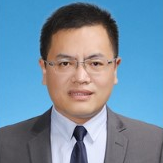Electrochemical Reaction and Energy Devices Based on Nanomaterials
A special issue of Nanomaterials (ISSN 2079-4991). This special issue belongs to the section "Energy and Catalysis".
Deadline for manuscript submissions: closed (30 August 2022) | Viewed by 3679
Special Issue Editors
Interests: solid state batteries; solid state electrolytes; solid state electrolytes interfaces
Interests: polymer elecroytes in litium-ion batteries; polymer elecroytes in dielectric, ferroelectric and piezoelectric polymers
Special Issues, Collections and Topics in MDPI journals
Special Issue Information
Dear Colleagues,
Energy storage materials and devices have gained rapid development in recent years. Nanostructured electrode and electrolyte materials have been widely applied in field of advanced energy storage devices such as batteries and supercapacitors. Nanomaterials with large surface area provide richer active sites, improved ionic and electronic conductivity compared to conventional materials, which offers a significant solution for developing high-energy and high-power energy density batteries and supercapacitors. Therefore, the anodes, cathodes, and composite solid electrolytes with nanostructure play a quite key role for building advanced lithium, sodium, potassium ion/metal batteries and supercapacitors.
The aim of this Special Issue will report the recent advancements and challenges in nanomaterials used as energy storage materials and devices. It is envisaged that Special Issue will cover the applications and research of nanomaterials in energy storage systems, including metal and ion batteries (Li, Na, K, Zn), Li-S batteries, supercapacitors, solid-state batteries, energy harvesting, and their energy storage mechanisms.
Prof. Dr. Yanbing He
Dr. Yanfei Huang
Guest Editors
Manuscript Submission Information
Manuscripts should be submitted online at www.mdpi.com by registering and logging in to this website. Once you are registered, click here to go to the submission form. Manuscripts can be submitted until the deadline. All submissions that pass pre-check are peer-reviewed. Accepted papers will be published continuously in the journal (as soon as accepted) and will be listed together on the special issue website. Research articles, review articles as well as short communications are invited. For planned papers, a title and short abstract (about 100 words) can be sent to the Editorial Office for announcement on this website.
Submitted manuscripts should not have been published previously, nor be under consideration for publication elsewhere (except conference proceedings papers). All manuscripts are thoroughly refereed through a single-blind peer-review process. A guide for authors and other relevant information for submission of manuscripts is available on the Instructions for Authors page. Nanomaterials is an international peer-reviewed open access semimonthly journal published by MDPI.
Please visit the Instructions for Authors page before submitting a manuscript. The Article Processing Charge (APC) for publication in this open access journal is 2900 CHF (Swiss Francs). Submitted papers should be well formatted and use good English. Authors may use MDPI's English editing service prior to publication or during author revisions.
Keywords
- nanomaterials for anodes
- nanomaterials for cathodes
- nanomaterials for electrolytes
- nanomaterials for metal batteries (Li, Na, K, Zn)
- nanomaterials for Li-S batteries
- nanomaterials for supercapacitors
- nanomaterials for ion batteries (Li, Na, K, Zn)
- nanomaterials for energy harvesting







